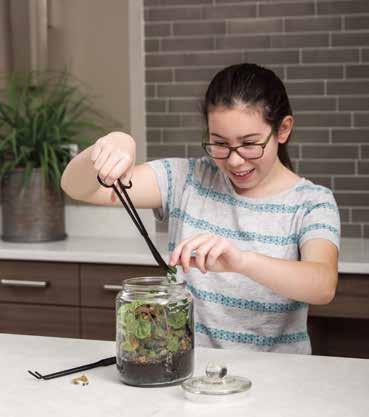
4 minute read
TRY A TERRARIUM
Try a Terrarium to Bring Nature Indoors Photo credit: Tracy Walsh by Martin Miron
on adults, but children don’t have the life experience to put things in perspective. “Are we there yet?” is their mantra. It’s important to find activities that connect kids (and adults) to nature while they’re inside during the winter. Patricia Buzo, author of the new book, A Family Guide to Terrariums for Kids, explains how these mini-greenhouses can provide a wealth of fascinating, educational and fun experiences for kids.
Advertisement
Buzo says, “I have nothing against keeping houseplants; in fact, I have over 100 of them! They [terrariums] are more than just a container for plants, and can incorporate creativity and vision to become a work of art.” Household items that can be recycled to make cost-free terrariums include old fishbowls, pickle jars, canning jars or even plastic salad containers from the grocery store. Buzo says she prefers glass containers because they tend to look better aesthetically, but can break and could be a concern with young children. Plastic is almost unbreakable and looks nice, she adds, but it scratches very easily.
“Making terrariums and caring for them is good for our mind and soul, not to mention learning things like fine motor skills and the science behind what makes plants tick. It’s a chance to work with your hands and get them dirty, it sparks creativity and is a great cure for boredom,” advises Buzo. “It’s also an opportunity to spend time together as a family learning a new skill and creating fond memories. Young and not-so-young alike can escape from everyday stressors and feel a sense of accomplishment in what they’ve created.”
Terrariums have certain advantages over potted plants. They can house species that are normally difficult to grow because of their need for humidity, which most homes lack due to air conditioning and heating in Midwest winters. Ferns and begonias that are prone to brown edges generally fare well in a container of the appropriate size. To ensure success, plan ahead, use plants that have the same growing requirements and make the terrarium bioactive. Most terrariums will also house understory plants that prefer indirect light. “These can be placed in a bright room within view of a window, but not sitting in direct sunlight,” notes Buzo. “Always do research to see what your plants’ exact needs are.”
A sealed terrarium can go months or even years without the need to add water, because the plants basically recycle the water that’s already there and very little is lost through evaporation. “I recommend doing a visual check weekly to see if there are any problem areas forming, such as mold or decaying leaves,” says Buzo. “These should be taken care of immediately or they could potentially lead to more difficult problems to remedy.”
The need for fertilizer depends partly on the type of plants used. Any excess fertilizer has nowhere to drain and can build up
Quarantine due to COVID-19 restrictions is hard enough
very quickly, potentially burning the plants. “So, if you choose to fer-

tilize, do so very sparingly (water it down to no more that 25 percent of the recommended dose on the bottle to be safe) and infrequently,” says Buzo. “Alternatively, add a small amount of slow-release fertilizer pellets to the soil when you set up the terrarium.”
Plants that become extremely large at maturity are inappropriate for a terrarium. Another type of plant with which care must be taken is anything in the succulent family, including cactus. While they can be planted in an open container such as a halfbowl, they may suffer in a sealed terrarium over the long term, likely leading to the death of the plant.
A terrarium’s plant life will change and grow over time, requiring simple maintenance at regular intervals, affording a chance to nurture a living thing and watch it grow. “The best part is once most people, including kids, are bitten by the terrarium bug so to speak, they will not want to stop at just one terrarium. It will be something that can be done again and again. And hey, terrariums make great gifts too!” advises Buzo. “What better feeling as a kid than to experience the pride that comes from giving someone they love a gift they created with their own two hands?”
A Family Guide to Terrariums for Kids is available at Amazon, Barnes & Noble, and also signed copies at DoodleBirdTerrariums.com. Find more information, books and terrarium supplies at DoodleBirdTerrariums.com.

At Cultivate, our goal is to make it easy to bring nature indoors. One of our favorite ways is by creating expertly designed terrariums that look great and are easy to care for. We love collaborating to fulfi ll your custom terrarium dreams.
CULTIVATE A MORE VERDANT LIFE


Houseplants ■ Succulents ■ Terrariums ■ Plant Supplies
SHOP IN-PERSON OR ONLINE

704 MAIN ST., EVANSTON 847-418-1289 www.cultivateurbanrainforest.com





